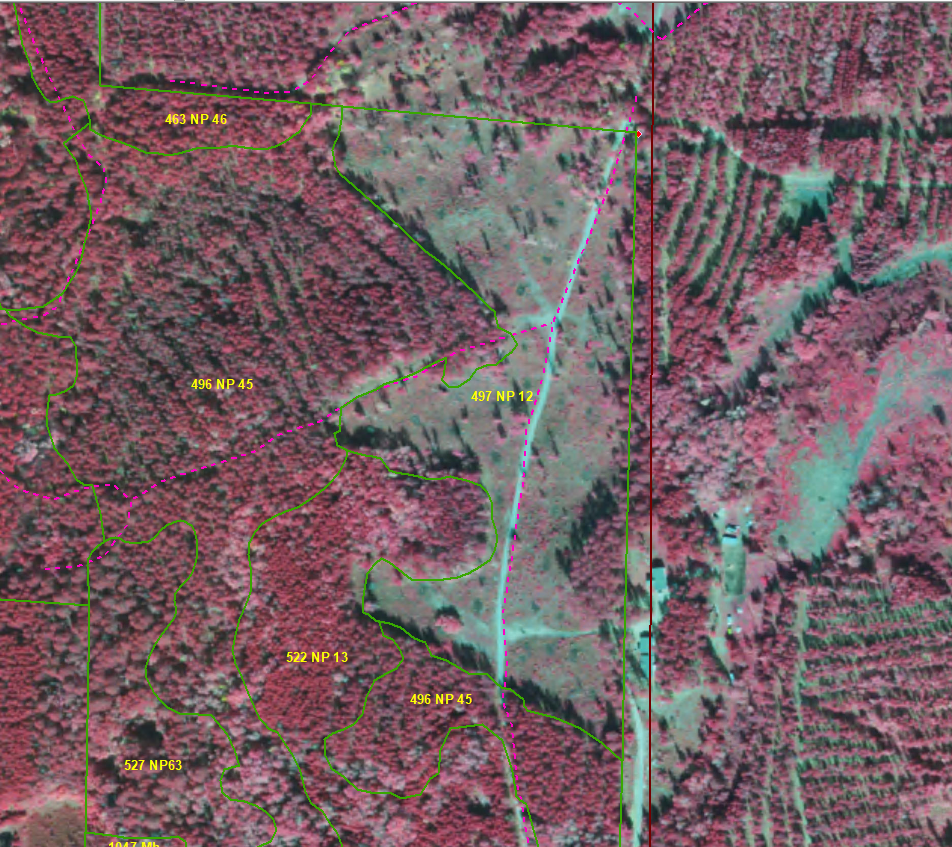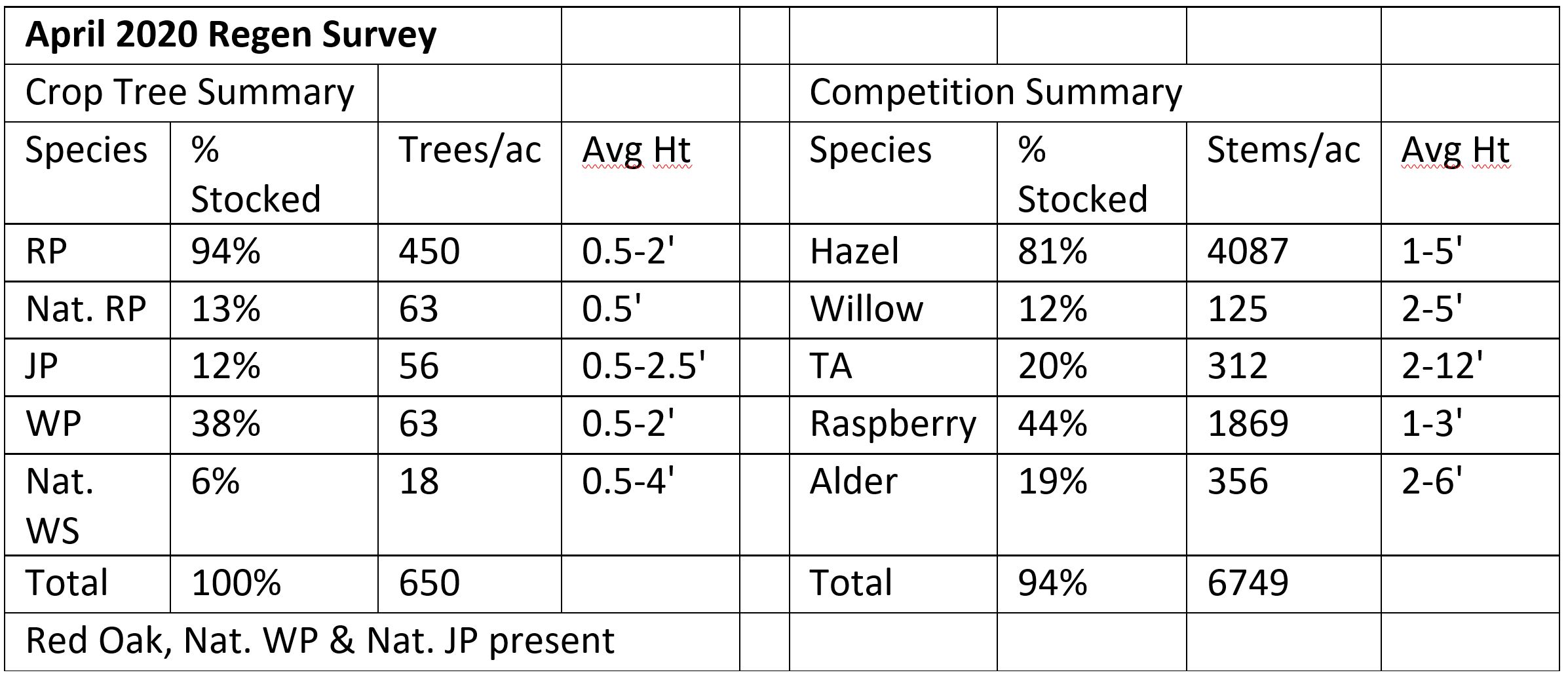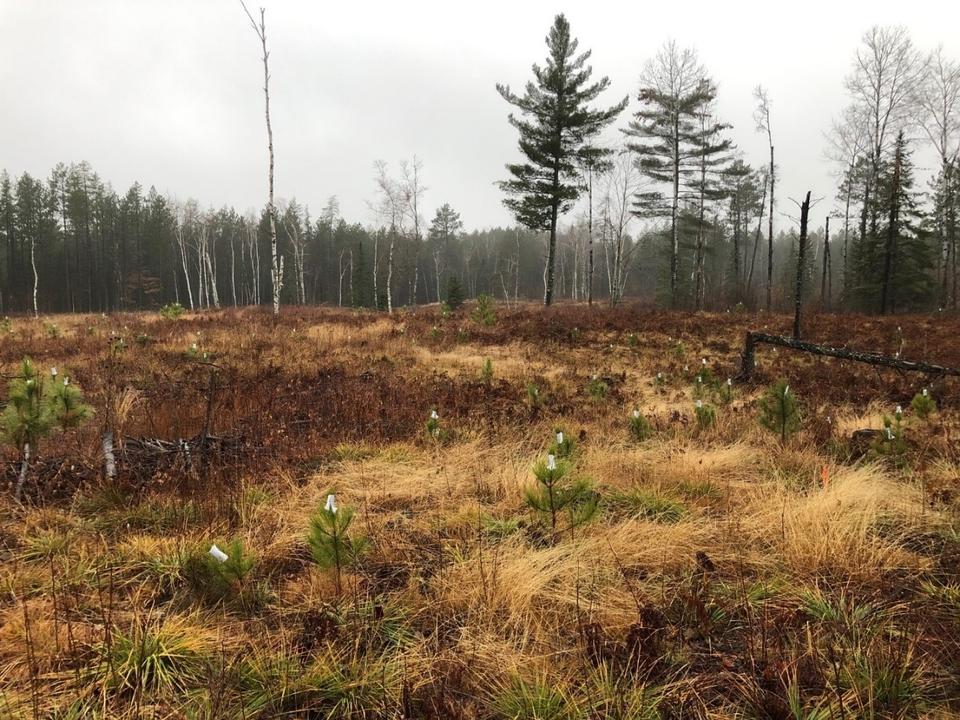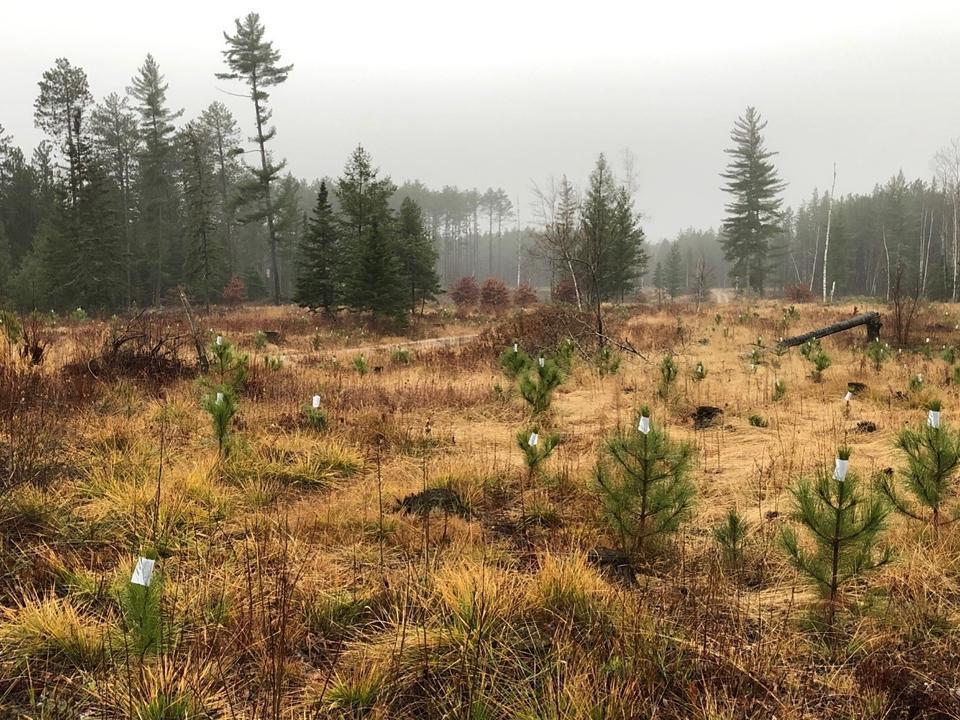Overview
This site was one of the first final harvests of natural origin red pine (NORP) on School Trust land in the Hibbing area. This case study looks at the use of both natural and artificial regeneration practices to regenerate a NORP site in a manner that mimics the structure and diversity of a stand reinitiated by catastrophic fire. A mixed species spatially variable planting was used to provide a level of insurance that we would successfully regenerate a healthy, fully stocked, mixed red pine stand that would continue to provide future forest products and revenue to the School Trust. This site was planted at densities of 400, 800 and 1,200 trees per acre in designated areas across the site.
Silviculture Objective(s)
Use a combination of natural and artificial regeneration practices to regenerate a natural origin red pine site with characteristics that mimic a natural origin stand in structure and diversity, while maintaining red pine as the dominant species.
Pre-treatment stand description and condition
Stand establishment and management history:
Around 1910 this stand was established through some catastrophic disturbance event. This stand had several selective thinning harvests over the past 25 years. The last marked thinning in this stand took place in the fall of 2010.
Pre-treatment species composition:
Stand composition included 39.9 cords per acre of red pine, along with scattered white pine, white spruce, jack pine, aspen, red oak, paper birch, balsam fir and red maple.
Understory composition included patches of advanced regeneration of white pine, white spruce, red oak, balsam fir, paper birch and aspen, along with patches of heavy hazel brush.
Pre-treatment forest health issues:
Diplodia shoot blight being present in mature tree was a concern for the young regenerating red pine.
Landowner objectives/situation:
Minnesota's Permanent School Fund receives income from economic activities on School Trust Lands which are managed by the MN DNR. Revenue on School Trust Lands is generated from forest management amongst other activities. Forest management activities on School Trust lands are planned and carried out by MN DNR.
As it relates to forest management on School Trust Lands, MN DNR has the authority and responsibility to achieve the goals outlined in Minnesota Statute, Section 84.027, Subd. 18 including:
• manage efficiently and with undivided loyalty;
• reduce operating expenses and maximize revenues deposited in the Permanent School Fund;
• maximize long-term economic returns while maintaining sound natural resource conservation and management principles;
• balance short-term revenues and long-term interests so that long-term benefits are not lost in an effort to maximize short-term gains;
• maintain the integrity of the trust and prevent the misapplication of its lands and its revenues.

Figure 1: Color infrared aerial photo of the stand area.
Silviculture Prescription
Clearcut with reserves final harvest on 19.5 acres, removing all red pine due to Diplodia concerns. Reserve scattered white pine, jack pine, white spruce, red maple, paper birch, red oak, balsam fir, aspen, and all non-hazardous snags for wildlife. Broadcast full tree skid during dry, non-frozen soil conditions to set back the heavy hazel brush and scarify the site for regeneration. Pile slash and chip or burn piles to remove as much of the Diplodia inoculum on cones and slash as possible. Follow harvest with a spring planting of red pine (600 trees per acre), white pine (100 trees per acre), and jack pine (100 trees per acre) at an average of 800 trees per acre incorporating a variable density spacing technique. Planting at a variable density, along with planting the majority of jack pine along the reserve area to provide a buffer between residual red pine and regeneration. Mechanical brush saw release as needed.
What actually happened during the treatment
The final harvest on this site took place in June 2017 using conventional logging equipment. The harvest removed 731 cords of red pine; a 1 acre red pine reserve was left along the east edge of the stand and all other species were reserved as noted above. Scarification from full tree skidding operation was excellent across much of the site, but the west edges had more scattered volume resulting in less wood skidding and less scarification in those areas. The slash was piled in several piles scattered over the site, which were burned in the fall of 2017.
In late May 2018, the site was planted with a smaller vendor over several days with 1-0 red pine and 1-0 jack pine container seedlings from PRT, and 3-0 white pine bare root seedlings from Badoura nursery. A spatially variable planting technique was used by planting the site in densities of 400, 800 and 1,200 trees per acre in designated areas. Total seedlings planted on the site were 11,400 red pine, 1,950 jack pine and 2,000 white pine for an average of 787 trees per acre. Mechanical brush saw release of conifer seedlings was completed August 5, 2021 in partnership with The Nature Conservancy. Mechanical release was chosen instead of chemical to help retain red oak, aspen, birch, maple and other species of diversity on site, but in a more intermediate/co-dominant canopy position in the future.
Post-treatment assessment
Following the three-year regeneration survey in April 2020 (Table 1) we realized there were several areas of the site not meeting our minimum regeneration standards that averaged less than 250 crop trees trees per acre, these areas totaled about 10 acres. At this time it was obvious a release was needed to allow the crop trees to continue to grow, followed by an interplant in these areas with very low crop tree densities. These very low crop tree densities occurred in areas with less mineral soil scarification from harvest and thus a higher presence of competition species causing mortality. In the spring of 2022, 10 acres of the site were interplanted with red pine seedlings from PRT at 600 trees per acre.
Table 1: 3 year regeneration survey.


Figure 2: photo of regenerating and protected red pine.
Plans for future treatments
Mechanical brush saw release as needed.
Costs and economic considerations
Revenue: final harvest $58,735.85 or $3,012.09 per acre.
Planting (19.5 acres in 2018): labor- $3039.30 or $156.02 per acre, seedlings- $2,656 or $136.21 per acre, total planting - $6,595.30 or $338.22 per acre.
Interplanting (10 acres in 2022): labor- $530 or $53 per acre, seedlings- $960 or $96 per acre, total interplant - $1,490 or $149 per acre.
Brush saw release: completed 8/5/21, in partnership with The Nature Conservancy, $0.00 cost to State. For reference average cost of brush saw release on state land in 2020 was $167/acre.
Total regeneration costs: $8,085.30 or $414.63 per acre.
Other notes
This prescription was a compromise through coordination with MN DNR Divisions of Wildlife and Ecological and Water Resources.
This case study will continue to be updated as further treatments are completed until site is free-to-grow.
For other similar prescriptions see: Regenerating Blueberry Hill natural origin red pine using a mix of artificial and natural regeneration (MN DNR) and Regenerating Bear Lake natural origin red pine using a mix of artificial and natural regeneration (MNDNR)
Climate adaptation considerations
Increase stand resilience to climate change through increased species diversity.
Summary / lessons learned / additional thoughts
This prescription balanced economic and ecological objectives by using a silvicultural strategy that favored both artificial and natural regeneration of red pine. It used leave tree retention, passive site prep that relied on timber harvest operations, advance regeneration, and variable density planting to achieve the desired results. Early results indicate that compositionally this stand is on track to the specified desired future condition, but future tending and monitoring will be needed to ensure the long-term success of the prescription.
Now that we have implemented this type of prescription on several different stands we are finding better results delaying planting by 1 growing season after harvest and implementing a mechanical site prep technique such as slash raking, anchor chaining or disc harrowing. We have started prescribing a late summer mechanical site prep prior to planting the following spring to get better control of the competition on site and provide a better seed bed for planting and natural seed opportunities.
When managing similar stands in the future with the similar objectives it would be more cost effective and reduce planting supervision efforts to designate areas and make it clear what spacing to plant different “zones”, and include this type of project on our regular planting contracts, instead of spending several days of planting supervision with a local contractor. This relates to productivity differences between large and small planting contractors and the agency staff time associated with overseeing a lower productivity, smaller vendor with fewer people planting.
Observations have also shown that relying solely on full tree logging for site prep results in a wide range of mineral soil exposure and competition control across the site, which in itself creates variable planting densities along with varying survival of seedlings.
This case study was reviewed by MN DNR Silviculture Program Staff Mike Reinikainen. Case study submitted on 04/24/2023.
